
A Carnegie library is a library built with money donated by Scottish-American businessman and philanthropist Andrew Carnegie. A total of 2,509 Carnegie libraries were built between 1883 and 1929, including some belonging to public and university library systems. 1,689 were built in the United States, 660 in the United Kingdom and Ireland, 125 in Canada, and 25 others in Australia, South Africa, New Zealand, Serbia, Belgium, France, the Caribbean, Mauritius, Malaysia, and Fiji.

The Carnegie Library of Pittsburgh is the public library system in Pittsburgh, Pennsylvania. Its main branch is located in the Oakland neighborhood of Pittsburgh, and it has 19 branch locations throughout the city. Like hundreds of other Carnegie libraries, the construction of the main library, which opened in 1895, and several neighborhood branches, was funded by industrialist Andrew Carnegie. The Pittsburgh area houses the first branches in the United States.

Carnegie Museums of Pittsburgh is a nonprofit organization that operates four museums in Pittsburgh, Pennsylvania, United States. The organization is headquartered in the Carnegie Institute and Library complex in the Oakland neighborhood of Pittsburgh. The Carnegie Institute complex, which includes the original museum, recital hall, and library, was added to the National Register of Historic Places on March 30, 1979.

Peabody & Stearns was a premier architectural firm in the Eastern United States in the late 19th century and early 20th century. Based in Boston, Massachusetts, the firm consisted of Robert Swain Peabody (1845–1917) and John Goddard Stearns Jr. (1843–1917). The firm worked on in a variety of designs but is closely associated with shingle style.

Alexander Wadsworth Longfellow Jr. was an American architect and nephew of poet Henry Wadsworth Longfellow.

The Carnegie Building, also known as the Carnegie Steel Building, was a high-rise building in Pittsburgh, Pennsylvania.

Bellefield Boiler Plant, also known as "The Cloud Factory" from its nickname's use in Michael Chabon's 1988 debut novel The Mysteries of Pittsburgh, is a boiler plant located in Junction Hollow between the Carnegie Institute of Pittsburgh and Carnegie Mellon University in the Oakland district of Pittsburgh, Pennsylvania.

The Carnegie Library of Homestead is a public library founded by Andrew Carnegie in 1898.
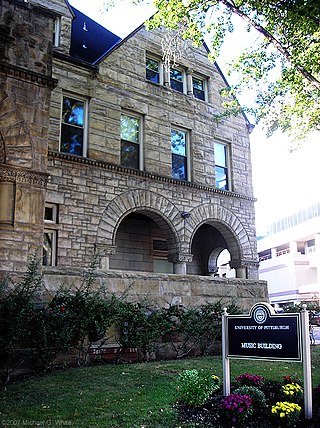
Longfellow, Alden & Harlow, of Boston, Massachusetts, and Pittsburgh, Pennsylvania, was the architectural firm of Alexander Wadsworth Longfellow Jr. (1854–1934), Frank Ellis Alden (1859–1908), and Alfred Branch Harlow (1857–1927). The firm, successors to H. H. Richardson, continued to provide structures in the Romanesque revival style established by Richardson that is often referred to as Richardsonian Romanesque.

The Braddock Carnegie Library in Braddock, Pennsylvania, is the first Carnegie Library in the United States. As such, the library was named a National Historic Landmark in 2012, following its listing on the National Register of Historic Places in 1973, and is on the Pittsburgh History and Landmarks Foundation's List of Historic Landmarks.
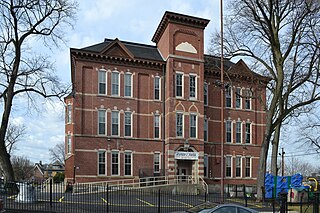
The Stephen C. Foster School, also known as the Stephen C. Foster Community Center, is a historic school building in the Central Lawrenceville neighborhood of Pittsburgh, Pennsylvania. It is named for composer Stephen Foster, whose father William Barclay Foster once owned the land on which the building is located. The school opened in 1886 and operated until 1939, when its students were transferred to the new elementary wing of Arsenal Junior High School. Since 1939, the building has been used as a community center.

Marion M. Steen was a Pittsburgh-based architect associated with a number of schools in the area.
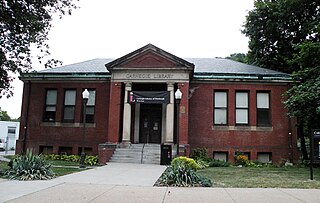
The West End Branch of the Carnegie Library of Pittsburgh, located at 47 Wabash Street in the West End neighborhood of Pittsburgh, Pennsylvania, opened on January 31, 1899. It was originally commissioned as part of Andrew Carnegie's first grant to Pittsburgh and was the third library in the Pittsburgh city system to open, following the Main Branch and the Lawrenceville Branch.
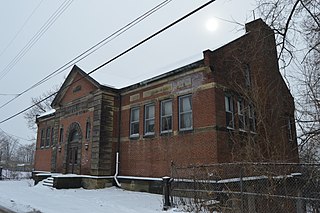
The Hazelwood Branch of the Carnegie Library of Pittsburgh, which is located at 4748 Monongahela Street in the Hazelwood neighborhood of Pittsburgh, Pennsylvania, was built in 1899. It was added to the List of City of Pittsburgh historic designations on July 28, 2004.
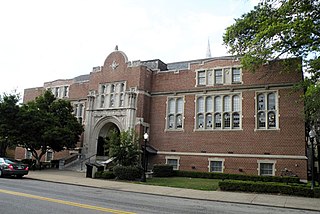
The Homewood Branch of the Carnegie Library of Pittsburgh is an historic library which is located in the city of in Pittsburgh, Pennsylvania. It was built at 7101 Hamilton Avenue in the Homewood South neighborhood, and opened on March 10, 1910.

The Mount Washington Branch of the Carnegie Library of Pittsburgh located at 315 Grandview Avenue in the Mount Washington neighborhood of Pittsburgh, Pennsylvania, was built in 1900. It was designed by the architectural firm Alden & Harlow, and it was added to the List of City of Pittsburgh historic designations on July 28, 2004 and the List of Pittsburgh History and Landmarks Foundation Historic Landmarks in 1989.
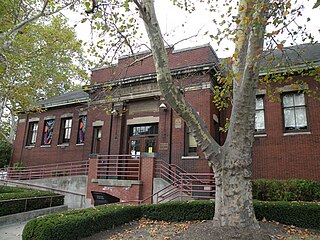
The Carnegie Library of Pittsburgh – South Side located at 2205 East Carson Street in the South Side Flats neighborhood of Pittsburgh, Pennsylvania, was built in 1909. It was designed by the architectural firm Alden & Harlow, and it was added to the List of Pittsburgh History and Landmarks Foundation Historic Landmarks in 1990.

The Former Pittsburgh Wash House and Public Baths Building is located at 3495 Butler Street in the Lawrenceville neighborhood of Pittsburgh, Pennsylvania. Built in 1904 in the Romanesque Revival architectural style, the building today serves as office space. The bath house was designated a Pittsburgh historic landmark in 2018 and was listed as a contributing property in the Lawrenceville Historic District in 2019.
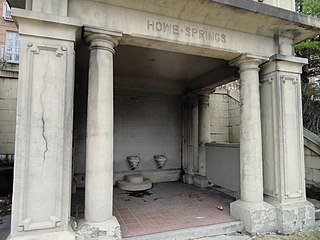
Howe Springs is located on the southern side of Fifth Avenue between South Highland Avenue and College Street in the Shadyside neighborhood of Pittsburgh, Pennsylvania. The spring was originally built in 1896 in the Romanesque architectural style, and was later renovated in 1912 in the neoclassical style.
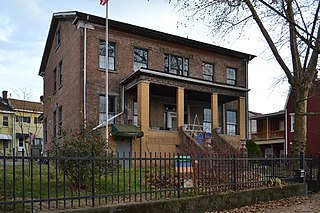
The Mowry-Addison Mansion is a historic house in the Upper Lawrenceville neighborhood of Pittsburgh, Pennsylvania, and a contributing property in the Lawrenceville Historic District. It was built in 1830–32 by Peter Mowry, a physician, and was originally part of a large estate that was subdivided into residential lots in 1872. The house is notable as a rare example of relatively well preserved Greek Revival architecture in Pittsburgh, and exemplifies the typical pattern of development in Lawrenceville in the mid to late 19th century. In 2020, the building was nominated as a Pittsburgh historic landmark by Preservation Pittsburgh, which stated that the mansion "is one of the last remaining and most significantly preserved regional ribbon farm dwellings from its period of construction."






















